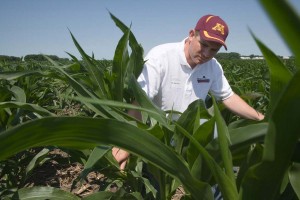By Daniel Kaiser, PhD, University of Minnesota
In areas where spring is cool and wet, banding fertilizer with the planter can benefit corn crops. Although application of dry fertilizer with the corn planter has played an important role historically, it has become less common with increasing acreages and planter sizes. Instead, liquid fertilizers have steadily replaced dry for supplying nutrients to the corn plant early in the growing season.
The primary benefit of applying low rates of fertilizer directly on the corn seed is more rapid growth early in the growing season. Increased early growth can be viewed as an insurance policy, ensuring that plants reach critical periods of growth faster. Low rates of phosphorus can significantly increase the amount of growth, even in fields where soil phosphorous test levels are high. Our research in Minnesota has demonstrated that as little at 10 lbs P2O5 applied with the planter can produce sizeable increases in plant mass early in the growing season. This increase has been shown to speed development and decrease the time to silking by one to two days.
Despite large increases in early plant mass, the probability of an increase in grain yield when using traditional starter sources is low in our experience in Minnesota, occurring roughly 10-15% of the time in soils testing high in phosphorus. And, once soils warm, the potential yield benefits of banded nutrients can decrease. At this time, the potential for an increase in yield is typically dictated by the presence or absence of a deficiency in one or more nutrients. Trials conducted over three years in Southern Minnesota that utilized a starter containing nitrogen, phosphorus, and potassium (and compared to potassium alone), clearly showed the benefits of starter phosphorus for increasing early plant mass, but also demonstrated that increases in grain yield were due to elements such as potassium or sulfur. The magnitude of yield response was not related to the magnitude of increased early plant growth, reinforcing the disconnect between responses early in the growing season and potential increases in corn grain yield. In other words, a 50% increase in biomass does not necessarily translate into a 50% increase in yield.
Due to the added cost of fertilizer, producers that use starter must weigh all options when deciding where money should be spent. Current Minnesota fertilizer guidelines indicate that small rates of nutrients applied in a starter can supply crop needs when soils test high for phosphorous or potassium. However, if soils test low, the amount of fertilizer that can safely be applied with the seed may be too low to match crop needs. In these situations, additional broadcast phosphorous or potassium is warranted. If broadcast phosphorous or potassium is applied at high enough rates, there is little benefit of additional nutrients applied in a starter fertilizer, but what has not yet been addressed is whether broadcast phosphorous or potassium rates can be reduced sufficiently to make the cost more economical. However, since other benefits of starter include reduced grain moisture—which can range from an average decrease of 0.5% to as much 1.0-1.5% in extreme circumstances—this alone can be enough to pay for the cost of some fertilizer sources, especially in years when grain is wetter in the fall.
Over time, we have learned what to expect when banding nutrients with corn seed. Our experience in Minnesota shows that while a grain yield response is possible when banding nutrients with corn seed, a grain moisture response is much more likely. In addition, while starter (banded) potassium can provide a higher chance of return, it simply may not be economical compared to broadcast applications.






